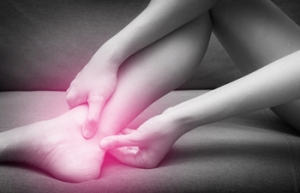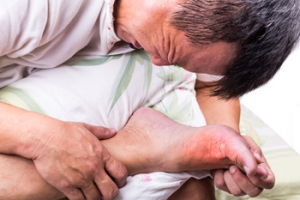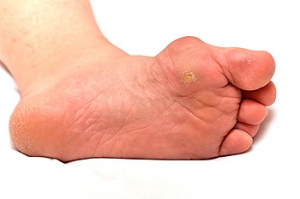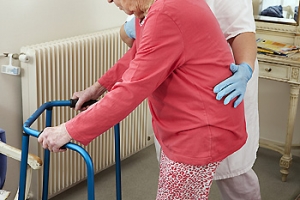
Foot Surgery
In most cases, foot surgery is often chosen as the last available option for conditions that have otherwise been unsuccessfully treated. Surgery may be necessary for several reasons, including the removal of foot deformities (e.g. bone spurs or bunions), arthritis problems, reconstruction due to injury, and congenital malformations (e.g. club foot or flat feet). Regardless of one’s age, foot surgery may be the only successful option for treatment for certain conditions.
The type of surgery one undergoes depends on the type of foot condition the patient has. For the removal of a bunion growth, a bunionectomy is necessary. If the bones in the feet need to be realigned or fused together, a surgical fusion of the foot is needed. For pain or nerve issues, a patient may require surgery in which the tissues surrounding the painful nerve are removed. Initially, less invasive treatments are generally attempted; surgery is often the last measure taken if other treatments are unsuccessful.
While in many cases surgery is often deemed as the final resort, choosing surgery comes with certain benefits. The associated pain experienced in relation to the particular condition is often relieved with surgery, allowing patients to quickly resume daily activities. The greatest benefit, however, is that surgery generally eliminates the problem immediately.
Podiatry history has shown that foot treatments continue to evolve over time. In the field of foot surgery, endoscopic surgery is just one of the many advanced forms of surgery. As technology vastly improves so too will the various techniques in foot surgery, which already require smaller and smaller incisions with the use of better and more efficient tools. Thanks to such innovations, surgery is no longer as invasive as it was in the past, allowing for faster and easier recoveries.
Aging and the Achilles Tendon
 The Achilles tendon is known to be the largest tendon in the body. It connects the heel to the calf muscles and is responsible for allowing the foot to point and flex. There are several symptoms patients notice if this tendon should become torn. These often include extreme pain in the back of the ankle, swelling, bruising, or a popping sound as the injury happens. It is common for the Achilles tendon to become weak as the aging process occurs, or if medical conditions such as diabetes or arthritis exist . Additionally, this condition may occur if you fall unexpectedly or suddenly step off a curb. If you have ruptured your Achilles tendon, it is suggested that you meet with a podiatrist who can discuss the best treatment options for you.
The Achilles tendon is known to be the largest tendon in the body. It connects the heel to the calf muscles and is responsible for allowing the foot to point and flex. There are several symptoms patients notice if this tendon should become torn. These often include extreme pain in the back of the ankle, swelling, bruising, or a popping sound as the injury happens. It is common for the Achilles tendon to become weak as the aging process occurs, or if medical conditions such as diabetes or arthritis exist . Additionally, this condition may occur if you fall unexpectedly or suddenly step off a curb. If you have ruptured your Achilles tendon, it is suggested that you meet with a podiatrist who can discuss the best treatment options for you.
Achilles tendon injuries need immediate attention to avoid future complications. If you have any concerns, contact one of our podiatrists of University Foot and Ankle Center, L.L.C. Our doctors can provide the care you need to keep you pain-free and on your feet.
What Is the Achilles Tendon?
The Achilles tendon is a tendon that connects the lower leg muscles and calf to the heel of the foot. It is the strongest tendon in the human body and is essential for making movement possible. Because this tendon is such an integral part of the body, any injuries to it can create immense difficulties and should immediately be presented to a doctor.
What Are the Symptoms of an Achilles Tendon Injury?
There are various types of injuries that can affect the Achilles tendon. The two most common injuries are Achilles tendinitis and ruptures of the tendon.
Achilles Tendinitis Symptoms
- Inflammation
- Dull to severe pain
- Increased blood flow to the tendon
- Thickening of the tendon
Rupture Symptoms
- Extreme pain and swelling in the foot
- Total immobility
Treatment and Prevention
Achilles tendon injuries are diagnosed by a thorough physical evaluation, which can include an MRI. Treatment involves rest, physical therapy, and in some cases, surgery. However, various preventative measures can be taken to avoid these injuries, such as:
- Thorough stretching of the tendon before and after exercise
- Strengthening exercises like calf raises, squats, leg curls, leg extensions, leg raises, lunges, and leg presses
If you have any questions please feel free to contact one of our offices located in East Brunswick and Monroe Township, NJ. We offer the newest diagnostic tools and technology to treat your foot and ankle needs.
Read more about What are Achilles Tendon InjuriesWhat are Achilles Tendon Injuries
The Achilles tendon is the strongest tendon in the human body. Its purpose is to connect the lower leg muscles and calf to the heel of the foot. This tendon is responsible for facilitating all types of movement, like walking and running. This tendon provides an enormous amount of mobility for the body. Any injuries inflicted to this tissue should be immediately brought up with a physician to prevent further damage.
The most common injuries that can trouble the Achilles tendon are tendon ruptures and Achilles tendinitis. Achilles tendinitis is the milder of the two injuries. It can be recognized by the following symptoms: inflammation, dull to severe pain, an increased flow of blood to the tendon, thickening of the tendon, and slower movement time. Tendinitis can be treated via several methods and is often diagnosed by an MRI.
An Achilles tendon rupture is trickier to heal, and is by far the most painful injury. It is caused by the tendon ripping or completely snapping. The results are immediate and absolutely devastating, and will render the patient immobile. If a rupture or tear occurs, operative and non-operative methods are available. Once the treatment begins, depending on the severity of the injury, recovery time for these types of issues can take up to a year.
Simple preventative measures can be taken as a means to avoid both injuries. Prior to any movement, taking a few minutes to stretch out the tendon is a great way to stimulate the tissue. Calf raises, squats, leg curls, leg extensions, leg raises, lunges, and leg presses are all suggested ways to help strengthen the lower legs and promote Achilles tendon health.
Many problems arise among athletes and people who overexert themselves while exercising. Problems can also happen among those who do not properly warm up before beginning an activity. Proper, comfortable shoes that fit correctly can also decrease tendon injuries. Some professionals also suggest that when exercising, you should make sure that the floor you are on is cushioned or has a mat. This will relieve pressure on the heels. A healthy diet will also increase tendon health.
It is very important to seek out a podiatrist if you believe you have an injury in the Achilles region. Further damage could result in severe complications that would make being mobile difficult, if not impossible.
Foods Related to Gout
 When excess uric acid exists in the bloodstream, crystals can form that lie in the joints of the big toe. When this occurs, it can produce a painful condition known as gout. There are several symptoms that are associated with this ailment, which often include severe pain and discomfort, redness, or swelling. Some patients are more susceptible to gout attacks if diuretics are taken, which can treat high blood pressure, in addition to taking low-dose aspirin. If episodes of gout are infrequent, avoiding them may be as simple as implementing healthy dietary changes. Foods that are high in purine levels can cause uric acid crystals to form in the joints, and it is beneficial to eliminate them from your diet. These foods include shellfish, red meat, and excessive alcohol. If the gout attacks become severe, it is suggested to consult with a podiatrist who can recommend treatment, which may include medication.
When excess uric acid exists in the bloodstream, crystals can form that lie in the joints of the big toe. When this occurs, it can produce a painful condition known as gout. There are several symptoms that are associated with this ailment, which often include severe pain and discomfort, redness, or swelling. Some patients are more susceptible to gout attacks if diuretics are taken, which can treat high blood pressure, in addition to taking low-dose aspirin. If episodes of gout are infrequent, avoiding them may be as simple as implementing healthy dietary changes. Foods that are high in purine levels can cause uric acid crystals to form in the joints, and it is beneficial to eliminate them from your diet. These foods include shellfish, red meat, and excessive alcohol. If the gout attacks become severe, it is suggested to consult with a podiatrist who can recommend treatment, which may include medication.
Gout is a foot condition that requires certain treatment and care. If you are seeking treatment, contact one of our podiatrists from University Foot and Ankle Center, L.L.C. Our doctors will treat your foot and ankle needs.
What Is Gout?
Gout is a type of arthritis caused by a buildup of uric acid in the bloodstream. It often develops in the foot, especially the big toe area, although it can manifest in other parts of the body as well. Gout can make walking and standing very painful and is especially common in diabetics and the obese.
People typically get gout because of a poor diet. Genetic predisposition is also a factor. The children of parents who have had gout frequently have a chance of developing it themselves.
Gout can easily be identified by redness and inflammation of the big toe and the surrounding areas of the foot. Other symptoms include extreme fatigue, joint pain, and running high fevers. Sometimes corticosteroid drugs can be prescribed to treat gout, but the best way to combat this disease is to get more exercise and eat a better diet.
If you have any questions please feel free to contact one of our offices located in East Brunswick and Monroe Township, NJ. We offer the newest diagnostic and treatment technologies for all your foot and ankle needs.
Read more about GoutGout
Gout is a form of arthritis that is caused by a buildup of uric acid crystals in the joints. This considered to be one of the most frequently recorded medical illnesses throughout history. Gout occurrences in the US have risen within the past twenty years and the condition now affects 8.3 million people which is 4% of all Americans. Researchers have found that gout affects men more than women and African-American men more than white men.
Symptoms of gout are warmth, swelling, discoloration, and tenderness in the affected joint area. The small joint on the big toe is the most common place for a gout attack to occur.
People who are obese, gain weight excessively, drink alcohol heavily, have high blood pressure, or have abnormal kidney function are more likely to develop gout. Furthermore, certain drugs and diseases are likely to increase levels of uric acid in the joints which eventually leads to gout. You are also more likely to develop gout if you eat a lot of meat and fish.
Many who experience gout attacks will experience repeated attacks over the years. Some people who have gout symptoms, may never have them again, but others may experience them several times a year. If you have gout symptoms throughout the year, you may have recurrent gout. Those who have gout should also be careful about their urate crystals collecting in their urinary tract, because this may lead to kidney stones.
Diagnosis for gout is done by checking the level of uric acid in the joints and blood. Your podiatrist may also prescribe medicine to reduce uric acid buildup in the blood, which will help prevent any gout attacks.
To treat gout, your podiatrist may also prescribe you Anti-inflammatory medication (NSAIDs) which will relieve the pain and swelling of a gout episode and it can also shorten a gout attack. Maintaining a healthy diet is also a proven method to prevent gout attacks.
The Difference Between Corns and Calluses
 Corns and calluses are both forms of hardened skin that appear on the foot, but they are not the same condition. Neither condition is dangerous, but both can cause discomfort or irritation. Corns and calluses usually develop as a reaction to pressure or friction. Standing for long periods of time, sweating, and wearing ill-fitting shoes make one more prone to developing corns or calluses. Calluses and corns vary in where they are likely to appear and their shape. Calluses usually appear on the soles of the feet, while corns often occur on the non-weight bearing parts of the skin. Calluses can vary in shape, while corns are normally small, round, and defined. Corns are also more likely to be more painful than calluses. If you are experiencing pain with either corns or calluses, consult with a podiatrist about the best treatment option for you.
Corns and calluses are both forms of hardened skin that appear on the foot, but they are not the same condition. Neither condition is dangerous, but both can cause discomfort or irritation. Corns and calluses usually develop as a reaction to pressure or friction. Standing for long periods of time, sweating, and wearing ill-fitting shoes make one more prone to developing corns or calluses. Calluses and corns vary in where they are likely to appear and their shape. Calluses usually appear on the soles of the feet, while corns often occur on the non-weight bearing parts of the skin. Calluses can vary in shape, while corns are normally small, round, and defined. Corns are also more likely to be more painful than calluses. If you are experiencing pain with either corns or calluses, consult with a podiatrist about the best treatment option for you.
If you have any concerns regarding your feet and ankles, contact one of our podiatrists of University Foot and Ankle Center, L.L.C. Our doctors will treat your foot and ankle needs.
Corns: What Are They? and How Do You Get Rid of Them?
Corns can be described as areas of the skin that have thickened to the point of becoming painful or irritating. They are often layers and layers of the skin that have become dry and rough, and are normally smaller than calluses.
Ways to Prevent Corns
There are many ways to get rid of painful corns such as wearing:
- Well-fitting socks
- Comfortable shoes that are not tight around your foot
- Shoes that offer support
Treating Corns
Treatment of corns involves removing the dead skin that has built up in the specific area of the foot. Consult with Our doctors to determine the best treatment option for your case of corns.
If you have any questions please feel free to contact one of our offices located in East Brunswick and Monroe Township, NJ. We offer the newest diagnostic and treatment technologies for all your foot and ankle needs.
Read more about Everything You Need to Know About CornsEverything You Need to Know About Corns
Corns are hard and thick areas of skin that form as a result of constant rubbing, friction, or pressure on the skin. They are patches of dead skin with a small plug toward the center. They may appear on the tops and sides of toes and can make walking painful.
Soft corns are typically thinner with a white color and rubbery texture. Soft corns tend to appear between the toes. Seed corns are another type of corn that appear in clusters and can be tender if they are on a weight-bearing part of the foot. Seed corns usually appear on the bottom of the foot and are likely caused by a blockage in sweat ducts.
While corns and calluses are somewhat similar, calluses are a bit different. Calluses are a patch of dead skin that can occur anywhere on the body. In comparison to corns, calluses are usually a bit larger in size. However, both corns and calluses are caused by increased friction on the skin.
There are some risk factors that may increase your chances of developing corns and calluses. If you have bunions, hammertoe, or a bone spur, you are more likely to develop a corn or callus on your foot.
While Corns and Calluses tend to disappear when the friction to the affected area ceases, the help of a podiatrist may be useful in the removal process. It is important to remove the dead skin around the area and this may be done in a few different ways. Moisturizing creams may be helpful in softening and removing the dead skin around the callus. You should never use razors or other pedicure equipment to remove your corns. Doing this may worsen your corn or callus and cause infection.
In some cases, corns and calluses may be caused by abnormal foot structure or walking motion. In such a case, you should seek a podiatrist’s assistance in order to correct the issue.
What Are Podiatrists?
 Podiatrists are doctors of podiatric medicine (DPM) and are qualified to diagnose and treat conditions that affect the foot or ankle. Podiatrists are also specialists in preventing, diagnosing, and treating lower extremity disorders, diseases, and injuries. They are the only doctors to receive specialized medical and surgical training and board certification in caring for the lower extremities. Oftentimes, they are the first to detect conditions like diabetes and cardiovascular disease because the foot is one of the first places in the body to exhibit symptoms. These physicians can specialize in various areas such as surgery and public health. They can also practice specialties like sports medicine, pediatrics, geriatrics, diabetic foot care, and more. If you are interested in learning more about podiatrists and what they do, then it would be beneficial to speak to an experienced podiatrist.
Podiatrists are doctors of podiatric medicine (DPM) and are qualified to diagnose and treat conditions that affect the foot or ankle. Podiatrists are also specialists in preventing, diagnosing, and treating lower extremity disorders, diseases, and injuries. They are the only doctors to receive specialized medical and surgical training and board certification in caring for the lower extremities. Oftentimes, they are the first to detect conditions like diabetes and cardiovascular disease because the foot is one of the first places in the body to exhibit symptoms. These physicians can specialize in various areas such as surgery and public health. They can also practice specialties like sports medicine, pediatrics, geriatrics, diabetic foot care, and more. If you are interested in learning more about podiatrists and what they do, then it would be beneficial to speak to an experienced podiatrist.
If you are experiencing pain in the feet or ankles, don’t join the stubborn majority refusing treatment. Feel free to contact one of our podiatrists from University Foot and Ankle Center, L.L.C. Our doctors can provide the care you need to keep you pain-free and on your feet.
What Is a Podiatrist?
Someone would seek the care of a podiatrist if they have suffered a foot injury or have common foot ailments such as heal spurs, bunions, arch problems, deformities, ingrown toenails, corns, foot and ankle problems, etc.
Podiatric Treatment
A podiatrist will treat the problematic areas of the feet, ankle or lower leg by prescribing the following:
- Physical therapy
- Drugs
- Orthotic inserts or soles
- Surgery on lower extremity fractures
A common podiatric procedure a podiatrist will use is a scanner or force plate which will allow the podiatrist to know the designs of orthotics. Patients are then told to follow a series of tasks to complete the treatment. The computer will scan the foot a see which areas show weight distribution and pressure points. The podiatrist will read the analysis and then determine which treatment plans are available.
If you have any questions please feel free to contact one of our offices located in East Brunswick and Monroe Township, NJ. We offer the newest diagnostic and treatment technologies for all your foot and ankle needs.
Read more about What is a Podiatrist?What is a Podiatrist?
The branch of medicine that is focused on the treatment, diagnosis, and study of disorders of the lower leg, ankle and foot is referred to as podiatry. Because people often spend a great deal of their time on their feet, many problems in this area can occur. A person seeks help from the field of podiatry when they need treatment for heel spurs, bunions, arch problems, deformities, ingrown toenails, corns, foot and ankle problems, infections, and problems with the foot that are related to diabetes and additional diseases.
To treat problems of the foot, ankle or lower leg, a podiatrist may prescribe physical therapy, drugs, perform surgery, or set fractures. Individuals may also be recommended to wear corrective shoe inserts, custom-made shoes, plaster casts and strappings in order to correct deformities.
When trying to gather information on a patient problem, a scanner or force plate may be used in order to design orthotics. During this procedure, patients are told to walk across a plate that is connected to a computer; the computer then takes a scan of the foot and indicates weight distribution and pressure points. The computer readouts will give the podiatrist information to help them determine the correct treatment plans.
Diagnosis is also provided through laboratory tests and x-rays. Through the foot, the first signs of serious problems such as heart disease, diabetes and arthritis can show up. For example, individuals that have diabetes may frequently have problems such as infections and foot ulcers because they experience poor circulation in the foot area. A podiatrist can then have consultations with patients when symptoms arise. Referrals will then be made to specialists that handle the greater health problems.
Some podiatrists have their own independent, private practices or clinics where they have a small staff and administrative personnel. Many podiatrists work within group practices. They usually spend time performing surgery in ambulatory surgical centers or hospitals, or visit patients in nursing homes. Podiatrists typically spend between 30 to 60 hours of week working. Some podiatrists specialize in public health, orthopedics, surgery, or primary care. Other fields include specialties in geriatrics, dermatology, pediatrics, diabetic foot care and sports medicine.
Some podiatrist specialists complete extra training in the area of foot and ankle reconstruction that results from the effects of physical trauma or diabetes. There are also surgeons that perform surgery of a cosmetic nature to correct bunions and hammertoes.
Falling Preventions for Elderly People
 Research has indicated that falling is the top cause of injuries in elderly Americans. There are many medical conditions that may result from falling. These may include hip fractures, brain injuries, in addition to trauma that may affect other parts of the body. There may be measures that can be implemented, which may help to prevent falling. These may include decluttering the home environment, having vision checks regularly, and wearing shoes and clothes that fit properly. Many elderly patients choose to drink plenty of fresh water daily, and this may help to avoid becoming light-headed, which may lead to fainting. If you would like to learn more about how to prevent falls, please consult with a podiatrist who can offer additional information.
Research has indicated that falling is the top cause of injuries in elderly Americans. There are many medical conditions that may result from falling. These may include hip fractures, brain injuries, in addition to trauma that may affect other parts of the body. There may be measures that can be implemented, which may help to prevent falling. These may include decluttering the home environment, having vision checks regularly, and wearing shoes and clothes that fit properly. Many elderly patients choose to drink plenty of fresh water daily, and this may help to avoid becoming light-headed, which may lead to fainting. If you would like to learn more about how to prevent falls, please consult with a podiatrist who can offer additional information.
Preventing falls among the elderly is very important. If you are older and have fallen or fear that you are prone to falling, consult with one of our podiatrists from University Foot and Ankle Center, L.L.C. Our doctors will assess your condition and provide you with quality advice and care.
Every 11 seconds, an elderly American is being treated in an emergency room for a fall related injury. Falls are the leading cause of head and hip injuries for those 65 and older. Due to decreases in strength, balance, senses, and lack of awareness, elderly persons are very susceptible to falling. Thankfully, there are a number of things older persons can do to prevent falls.
How to Prevent Falls
Some effective methods that older persons can do to prevent falls include:
- Enrolling in strength and balance exercise program to increase balance and strength
- Periodically having your sight and hearing checked
- Discuss any medications you have with a doctor to see if it increases the risk of falling
- Clearing the house of falling hazards and installing devices like grab bars and railings
- Utilizing a walker or cane
- Wearing shoes that provide good support and cushioning
- Talking to family members about falling and increasing awareness
Falling can be a traumatic and embarrassing experience for elderly persons; this can make them less willing to leave the house, and less willing to talk to someone about their fears of falling. Doing such things, however, will increase the likelihood of tripping or losing one’s balance. Knowing the causes of falling and how to prevent them is the best way to mitigate the risk of serious injury.
If you have any questions, please feel free to contact one of our offices located in East Brunswick and Monroe Township, NJ. We offer the newest diagnostic and treatment technologies for all your foot care needs.
Read more about Falls PreventionBlog Archives
- April 2024
- March 2024
- February 2024
- January 2024
- December 2023
- November 2023
- October 2023
- September 2023
- August 2023
- July 2023
- June 2023
- May 2023
- April 2023
- March 2023
- February 2023
- January 2023
- December 2022
- November 2022
- October 2022
- September 2022
- August 2022
- July 2022
- June 2022
- May 2022
- April 2022
- March 2022
- February 2022
- January 2022
- December 2021
- November 2021
- October 2021
- September 2021
- August 2021
- July 2021
- June 2021
- May 2021
- April 2021
- March 2021
- February 2021
- January 2021
- December 2020
- November 2020
- October 2020
- September 2020
- August 2020
- July 2020
- June 2020
- May 2020
- April 2020
- March 2020
- February 2020
- January 2020
- December 2019
- November 2019
- October 2019
- September 2019
- August 2019
- July 2019
- June 2019
- May 2019
- April 2019
- March 2019
- February 2019
- January 2019
- December 2018
- November 2018
- October 2018
- September 2018
- August 2018
- July 2018
- June 2018
- May 2018
- April 2018
- March 2018
- February 2018
- January 2018
- December 2017
- November 2017
- October 2017
- September 2017
- August 2017
- July 2017
- June 2017
- May 2017
- April 2017
- March 2017
- February 2017
- January 2017
- December 2016
- November 2016
- October 2016
- September 2016
- August 2016
- July 2016
- June 2016
- May 2016
- April 2016
- March 2016
- February 2016
- January 2016
- December 2015
- November 2015
- October 2015
- September 2015
- August 2015
- July 2015
- June 2015
- May 2015
- April 2015
- March 2015
- February 2015
- January 2015
- December 2014
- November 2014
- October 2014
- September 2014
- August 2014
- July 2014









